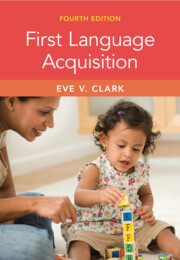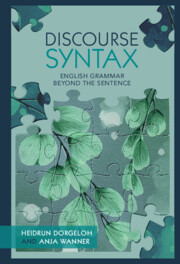Refine search
Actions for selected content:
27 results
7 - Creating a language-rich environment
-
- Book:
- Intentional Practice with Infants and Toddlers
- Published online:
- 17 June 2025
- Print publication:
- 12 June 2025, pp 167-199
-
- Chapter
- Export citation
3 - Ideologies of Language Use in an EMI University in Hong Kong
- from Part I - Ideologies and Educational Policies
-
-
- Book:
- Critical English Medium Instruction in Higher Education
- Published online:
- 31 January 2025
- Print publication:
- 06 February 2025, pp 37-53
-
- Chapter
- Export citation
Chapter 3 - What Are the Perspectives and Levels of an Analysis?
-
- Book:
- Introducing Practical Discourse Analysis
- Published online:
- 20 December 2024
- Print publication:
- 09 January 2025, pp 67-96
-
- Chapter
- Export citation
18 - The Speech Production of Bilingual Adults
- from Part IV - The Phonetics and Phonology of the Bilingual Adult
-
-
- Book:
- The Cambridge Handbook of Bilingual Phonetics and Phonology
- Published online:
- 14 November 2024
- Print publication:
- 21 November 2024, pp 407-425
-
- Chapter
- Export citation

First Language Acquisition
-
- Published online:
- 01 November 2024
- Print publication:
- 20 June 2024
-
- Textbook
- Export citation
1 - Acquiring language
-
- Book:
- First Language Acquisition
- Published online:
- 01 November 2024
- Print publication:
- 20 June 2024, pp 1-22
-
- Chapter
- Export citation
5 - From the Neck Up: Facial Gestures in Dialogue
- from Part I - Gestural Types: Forms and Functions
-
-
- Book:
- The Cambridge Handbook of Gesture Studies
- Published online:
- 01 May 2024
- Print publication:
- 18 April 2024, pp 112-130
-
- Chapter
- Export citation
1 - On Actors, Architecture, and L2 Advancedness in Higher Education
-
- Book:
- Second Language Identity
- Published online:
- 27 July 2023
- Print publication:
- 10 August 2023, pp 1-10
-
- Chapter
- Export citation
8 - Differential Object Marking and Clitic Doubling in Romanian as a Heritage Language
-
- Book:
- Native Speakers, Interrupted
- Published online:
- 15 December 2022
- Print publication:
- 22 December 2022, pp 205-226
-
- Chapter
- Export citation
7 - Differential Object Marking in Hindi as a Heritage Language
-
- Book:
- Native Speakers, Interrupted
- Published online:
- 15 December 2022
- Print publication:
- 22 December 2022, pp 183-204
-
- Chapter
- Export citation
6 - Differential Object Marking in Spanish as a Heritage Language
-
- Book:
- Native Speakers, Interrupted
- Published online:
- 15 December 2022
- Print publication:
- 22 December 2022, pp 159-182
-
- Chapter
- Export citation

Discourse Syntax
- English Grammar Beyond the Sentence
-
- Published online:
- 20 October 2022
- Print publication:
- 27 October 2022
26 - Academic and Professional Discourse in Intercultural Pragmatics
- from Part IV - Intercultural Pragmatics in Different Types of Communication
-
-
- Book:
- The Cambridge Handbook of Intercultural Pragmatics
- Published online:
- 29 September 2022
- Print publication:
- 20 October 2022, pp 683-710
-
- Chapter
- Export citation
Language Matters: Developing Inclusive, Strengths-Based Practice in a Cluster of Resource Teachers: Learning and Behaviour
-
- Journal:
- Australasian Journal of Special and Inclusive Education / Volume 46 / Issue 2 / December 2022
- Published online by Cambridge University Press:
- 26 September 2022, pp. 138-150
-
- Article
-
- You have access
- Open access
- HTML
- Export citation
A study on the executive functioning skills of Greek–English bilingual children – a nearest neighbour approach
-
- Journal:
- Bilingualism: Language and Cognition / Volume 26 / Issue 1 / January 2023
- Published online by Cambridge University Press:
- 08 July 2022, pp. 78-94
-
- Article
-
- You have access
- Open access
- HTML
- Export citation
1 - Introduction
-
- Book:
- Cross-Cultural Pragmatics
- Published online:
- 17 September 2021
- Print publication:
- 30 September 2021, pp 1-12
-
- Chapter
- Export citation
Acculturation through the lens of language: Syrian refugees in Canada and Germany
-
- Journal:
- Applied Psycholinguistics / Volume 41 / Issue 6 / November 2020
- Published online by Cambridge University Press:
- 26 October 2020, pp. 1351-1374
-
- Article
- Export citation
Documenting bilingual experiences in the early years: Using the CECER-DLL Child and Family and Teacher Questionnaires
-
- Journal:
- Bilingualism: Language and Cognition / Volume 23 / Issue 5 / November 2020
- Published online by Cambridge University Press:
- 12 October 2020, pp. 958-963
-
- Article
- Export citation
The roles of language use and vocabulary size in the emergence of word-combining in children with complex neurodevelopmental disabilities
-
- Journal:
- Journal of Child Language / Volume 48 / Issue 1 / January 2021
- Published online by Cambridge University Press:
- 28 May 2020, pp. 202-214
-
- Article
- Export citation
2 - Language as a Representation of Thought
-
- Book:
- Cognitive Discourse Analysis
- Published online:
- 23 January 2020
- Print publication:
- 13 February 2020, pp 32-56
-
- Chapter
- Export citation
